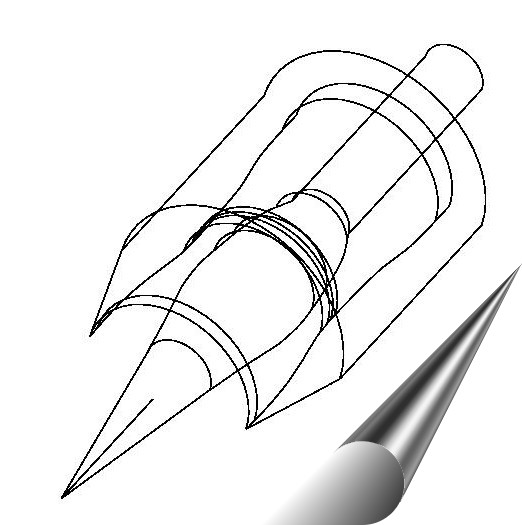|
|
|
Mixed-Compression Inlet |
|||
|
|
|
|
Introduction The focus of this research is to develop methods to improve the operation of mixed-compression inlets. Mixed-compression inlets are a type of airplane inlet that is designed to operate efficiently at a freestream Mach numbers of around 2.5: in other words, for flight at over twice the speed of sound. One of our goals in this research is to accurately model the physics of the bleed process in the context of a mixed compression inlet. In a mixed-compression inlet, the boundary-layer suction is needed to To model the bleed process in these inlets, a series of bleed boundary conditions have been developed that can be used in CFD simulations. The work is advantageous for several reasons. Able to model the inlet with few grid points - no need to develop grid and geometry for flow through the plenum and holes. Accurately model physics of the flow with few grid points In the future, bleed boundary conditions such as these could be used to develop bleed configurations that achieve design criteria for mixed-compression inlets, develop bleed control systems to optimize and control inlet performance and to Background One of the difficulties associated with supersonic flight involves the method by which air is supplied to the engine for use in combustion. The compressors used to power the aircraft need air at subsonic speeds to operate effectively (one can just imagine the horrendous shock structures that would exist if air at supersonic speeds impinged upon the impellers). The question then becomes one of how to deliver the air from the surroundings (supersonic speeds) to the engine face (subsonic speeds). Most of the inlets that are used in supersonic flight today are external compression inlets. This means that the terminal shock occurs at the entrance to the inlet and that the flow is subsonic throughout the inlet to the engine face. A classic example of this type of inlet are the sharp-edged air intakes on the sides of the fuselage of an F-18 fighter jet. Mixed-compression inlets, on the other hand, allow the flow to be supersonic within a portion of the inlet. The terminal shock is located inside the inlet and the shape of the inlet can be changed by moving either the inner centerbody or the outer surface (cowl) to re-position the terminal shock for optimum efficiency in flight. As a result of this configuration mixed-compression inlets are capable of high Mach number flight and they are exceptionally efficient when operating at their design Mach number. There are, however, numerous design issues that have plagued this design and these are responsible for the inlets being used only in missiles and a in limited number of (primarily) military aircraft. For example, inlet unstart and buzz are several of the features of mixed-compression inlets that the scientific community has been wrestling with since the mid-1960's to bring this approach to regular commercial use. Typically, mixed-compression inlets perform poorly at subsonic speeds. This inlet was designed by researchers at NASA Glenn in the late 1960's to have a high transonic mass flow rate in addition to being capable of high mach number flight
|
|
The inlet studied is an axisymmetric, mixed-compression inlet designed for operations at Ma=2.65. Program used to simulate flow -- CFL3D Post processing was accomplished using custom programs as well as two commercial software packages: Fieldview and TecPlot
|
|
|
Inviscid Start-Up of Inlet |
||||
|
Link to additional information. |
|
||||
|
|
Viscosity & Bleed Initiated |
||||
|
Mach contours - bleed with boundary layer (b.l.) development (1).. |
|
||||
|
|
|||||
|
|
|||||
|
|
Link to additional information. |
||||
|
|
|
||||
|
|
|
|
|
||
|
|
|
|
|
||
|
|
|
|
|
||
|
|
|
|
|
||
